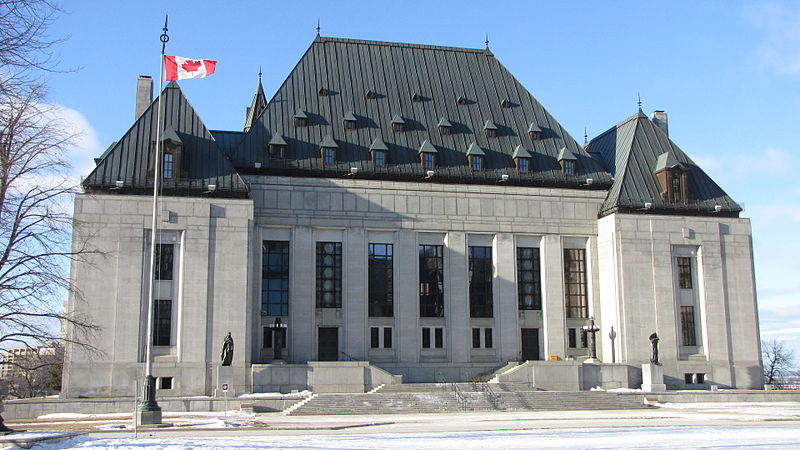Canadian Supreme Court Allows Corporate Liability for International Law Violations
The significance of this decision will likely extend well beyond Canada.

Published by The Lawfare Institute
in Cooperation With

On Feb. 28, the Supreme Court of Canada rendered a landmark judgment in the case of Nevsun Resources Ltd. v. Araya. This case raised a largely unexplored question in Canadian law: whether plaintiffs can bring civil claims in Canada for human rights violations committed abroad. As Justice Rosalie Abella wrote in the opening of her majority judgment, this appeal involved “the application of modern international human rights law, the phoenix that rose from the ashes of World War II and declared global war on human rights abuses.”
And the facts of the case are indeed grisly. The plaintiffs, refugees from Eritrea, claimed that Nevsun Resources, a Canadian mining company based in British Columbia, had been complicit in breaches of international human rights law—including forced labor, slavery, and torture, by the Eritrean government. As summarized by the decision below from the British Columbia Court of Appeal:
The plaintiffs allege that Nevsun entered into a “commercial venture” with Eritrea for the development of a large mine in that country and that through a chain of subsidiary corporations, it continues to own a 60% interest therein. Located near Asmara, the Bisha mine produces gold, copper and zinc and constitutes an important source of revenue for the Eritrean economy.
The plaintiffs assert that Nevsun engaged the Eritrean military and corporations controlled by it and by the [People’s Front for Democracy and Justice, Eritrea’s ruling party] to build the mine and related infrastructure. For this purpose, the military deployed or provided forced labour, conscripted under Eritrea’s National Service Program. The plaintiffs say they were among those forced to work at the mine in inhuman conditions and under the constant threat of physical punishment, torture and imprisonment, even after they had served their periods of conscription in the military.
In its appeal, Nevsun argued that the plaintiffs’ claims should be struck without consideration of the merits, on the basis that (a) the act of state doctrine applied, such that Canadian courts lacked subject-matter jurisdiction over any of the plaintiffs’ claims, and (b) there existed no separate cause of action in Canadian tort law for breaches of customary international law.
In a closely divided decision, the Supreme Court dismissed Nevsun’s appeal. Formally, this allowed the plaintiffs’ claims to proceed on the basis that Nevsun had not met the standard for a motion to strike by showing that it was “plain and obvious” that the claims could not succeed. Nonetheless, the court’s reasoning is far-reaching. And given the international attention the dispute has attracted—notably, U.S. nongovernmental organizations filed amicus briefs before both the Supreme Court of Canada and the Court of Appeal—it appears likely the significance of this decision will extend well beyond Canada.
The Court’s Decision
The five justices in the majority, as well as two of the four dissenting justices, rejected the act of state doctrine as part of Canadian law. This Anglo-American common law doctrine, a close cousin of foreign state immunity, applies where the lawfulness of a foreign state’s actions are challenged in a proceeding, irrespective of whether the foreign state itself is a party. As described by Justice John Marshall Harlan in Banco Nacional de Cuba v. Sabbatino, 376 U.S. 398 (1964):
The act of state doctrine in its traditional formulation precludes the courts of this country from inquiring into the validity of the public acts a recognized foreign sovereign power committed within its own territory.
Despite its extensive application by courts in the U.S. and elsewhere, however, there has been almost no Canadian judicial consideration of the act of state doctrine before Nevsun. No case had ever held one way or the other if the doctrine even existed in Canadian law.
In a detailed and critical examination of the doctrine’s history and modern application, Justice Abella observed that there has been “a proliferation of limitations on, and exceptions to, the act of state doctrine in England, reflecting an attempt to respond to the difficulties of applying a single doctrine to a heterogeneous collection of issues,” resulting in “considerable confusion” in the more recent English and Australian decisions applying the doctrine.
Abella wrote that, instead of employing the act of state doctrine—which she described as “largely defined by its limitations”—Canadian common law had, through jurisprudential developments in conflict of laws and judicial restraint, “completely subsumed” the principles underlying the doctrine. In short, there is no act of state doctrine in Canadian law, nor any need for such a doctrine. Under ordinary conflict of laws principles, Canadian courts may give effect to foreign law, but they also have the “judicial discretion to decline to enforce foreign laws where such laws are contrary to public policy, including respect for public international law.” Similarly, while judicial restraint counsels that courts should “refrain from making findings which purport to be legally binding on foreign states, [they] are free to inquire into foreign law questions when doing so is necessary or incidental to the resolution of domestic legal controversies properly before the court.” Neither of these principles, according to Abella, barred the plaintiffs’ claims.
The majority and dissenting opinions agreed that through the doctrine of adoption, customary international law is automatically incorporated into Canadian law in the absence of conflicting legislation. This is well accepted in Canadian law, and indeed in the law of most countries, including that of the United States. Similarly, the majority and the dissenting opinions agreed that certain norms of customary international law “prohibit conduct regardless of whether the perpetrator is a state.”
The majority made new law, however, concerning whether such norms could apply to a corporation as well as to individuals, and what adoption of such norms entailed with respect to domestic remedies.
On the first point, Justice Abella emphasized that in light of the postwar development of international human rights law, “there is no longer any tenable basis for restricting the application of customary international law to relations between states.” From this uncontroversial premise, however, she concluded that “there is no reason, in principle, why ‘private [nonstate] actors’ excludes corporations.” Relying principally on the work of law professor Harold Koh, Abella held that “it is not ‘plain and obvious’ that corporations today enjoy a blanket exclusion under customary international law from … liability for violations of ‘obligatory, definable, and universal norms of international law.’”
On the second point, Abella began from the principle that “where there is a right, there must be a remedy for its violation.” To Nevsun’s argument that the plaintiffs’ allegations were adequately addressed by torts recognized under Canadian law—such as battery, unlawful confinement, conspiracy and negligence, which the plaintiffs had also pleaded—she responded that it was “at least arguable” that existing torts were insufficient, noting that norms of customary international law were inherently different: “The profound harm resulting from their violation is sufficiently distinct in nature from those of existing torts that, as the workers say, ‘[i]n the same way that torture is something more than battery, slavery is more than an amalgam of unlawful confinement, assault and unjust enrichment’.”
The majority left the question of legal remedy to be decided by the trial judge, though it suggested that rather than recognizing new nominate torts as the plaintiffs had argued—such as a tort of forced labor or slavery—the unique nature of international law and the doctrine of adoption may favor a “direct approach” by which “a breach by a Canadian company can … be directly remedied based on a breach of customary international law.”
Two Dissents
There were two sets of dissents: a partial dissent, authored by Justices Malcolm Rowe and Russell Brown, and another dissent, written by Justice Suzanne Cote on behalf of herself and Justice Michael Moldaver.
Dissenting in part, Justices Rowe and Brown agreed with the majority on the act of state doctrine, but would have struck out the plaintiffs’ claims in tort for Nevsun’s breaches of customary international law, which in their view disclosed no reasonable cause of action and were bound to fail.
Their first point of disagreement with the majority centered on the effect of adoption. For the dissent, the question was not whether customary international law prohibits slavery and torture—obviously, it does—but whether that criminal prohibition requires Canadian law to also recognize a civil remedy for its breach. As they pointed out, just a few years earlier, in Kazemi Estate v. Islamic Republic of Iran, the court had found no such obligation. Nor could the doctrine of adoption transform “a general prohibition upon states and criminal prohibitions upon individuals” into a rule for civil liability. In their view, “this would afford the doctrine of adoption a role it cannot play.” Further, recognizing a novel cause of action for violation of customary international law is beyond the role of the common law courts to “develop the law incrementally” and is instead the kind of “fundamental reform” that should be left to the legislative branch.
The dissenting justices stated further that “it is plain and obvious that corporations are excluded from direct liability at customary international law.” They sharply criticized the majority for relying on a “lone essay” by Koh, and generally dismissed U.S. authorities as unhelpful in light of the influence of the “hoary and historically unique” U.S. Alien Tort Statute on the “peculiar” U.S. approach to the doctrine of adoption. At most, the “proposition that such liability has been recognized is equivocal,” the justices wrote. But they added, again quoting Kazemi, that “customary international law is, by its very nature, unequivocal. It is not binding law if it is equivocal.”
While this may overstate the particularity of U.S. law somewhat, other international law experts have come to similar conclusions about corporate liability. The dissenting justices cited the 2007 report authored by Harvard Professor John Ruggie, in his role as the U.N. secretary general’s special representative for business and human rights; in subsequent writings, Ruggie has concluded that corporations have a responsibility, not a duty, to respect international human rights and notes that “respecting rights is not an obligation current international human rights law generally imposes directly on companies.”
Finally, Justices Rowe and Brown rejected the plaintiffs’ alternative legal theory of recognizing new domestic torts “inspired by international law.” Existing Canadian tort law, in their view, already addresses much of the alleged conduct: “[S]ince all torture is battery (or intentional infliction of emotional distress), albeit a particularly severe form thereof, it does not need to be recognized as a new tort. Our law, as is, furnishes an appropriate cause of action.” While slavery and forced labor may meet the test for recognizing new torts, “in that each may capture conduct not independently captured in [existing] torts,” for prudential and policy reasons, novel torts “should not be recognized for the first time in a proceeding based on conduct that occurred in a foreign territory.”
In the second dissent, Justice Cote, writing for herself and Justice Moldaver, agreed with Brown and Rowe that the plaintiffs’ claims based on customary international law should be struck for failing to disclose a reasonable cause of action. Côté went further, however, and would have held that the act of state doctrine does exist in Canadian jurisprudence, and rendered the plaintiff’s claims nonjusticiable. While a Canadian court “has the institutional capacity to consider international law questions,” she wrote, “it is not legitimate for it to adjudicate claims between private parties which are founded upon an allegation that a foreign state violated international law.” For a court to adjudicate such a claim would be to intrude on the executive’s conduct of Canada’s international relations.
Implications
The ultimate result in this dispute remains to be determined as the case returns to the trial court. But Nevsun is already a momentous case for several reasons. Canadian companies now could face liability for overseas operations that breach norms of customary international law. Recently, multiple Canadian resources companies have been in the spotlight for alleged human rights abuses. In Papua New Guinea, for example, Human Rights Watch has reported that private security personnel employed by Toronto-based Barrick Gold committed gang rape and other abuses. A 2016 report from Osgoode Hall Law School linked 28 Canadian mining companies to 44 deaths and 403 injuries in Latin America between 2000 and 2015, and called for the Canadian government to implement more “robust accountability” mechanisms.
Last year, the Canadian government announced the appointment of the first Canadian ombudsperson for responsible enterprise, who will review “claims of alleged human rights abuses arising from the operations of Canadian companies abroad in the mining, oil and gas, and garment sectors.” The court’s holding in Nevsun will likely further drive accountability on the part of Canadian resources companies for their operations abroad.
Nevsun also marks a significant change in Canadian, and potentially international, law. Looming large for both the majority and the dissent is the court’s 2014 decision in Kazemi, concerning a suit against the Iranian government and several of its officials by the family of the late Canadian photojournalist Zahra Kazemi, who had been arrested, tortured and murdered while visiting Iran in 2003. By an eight-justice majority, the court had held that Canada’s State Immunity Act precluded reading in a common law exception to immunity based on any purported customary international law obligation for states to provide a civil remedy for breaches of human rights. Further, as Justices Rowe and Brown noted in their dissent in Nevsun, the majority in Kazemi stated—albeit in dicta—that state practice did not support the existence of such a binding obligation.
The lone dissenting judge in Kazemi, who would have held that customary international law required just such a civil remedy, and would have read the statute accordingly, was Justice Abella. Her majority opinion in Nevsun is undoubtedly a kind of vindication. Absent the constraints of the express statutory language at issue in Kazemi, this was an opportunity for the court to develop Canadian common law, and international practice, toward greater accountability for human rights violations by nonstate actors.
Internationally, the court’s holding in Nevsun could inspire other national courts to follow Canada’s lead. Abella wrote in her opinion that international human rights norms “were not meant to be theoretical aspirations or legal luxuries, but moral imperatives and legal necessities.” Perhaps other countries will heed her prescription.





